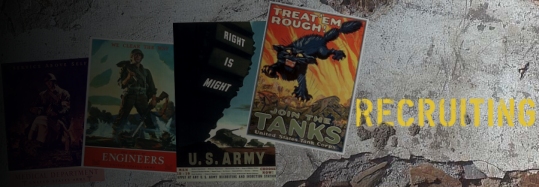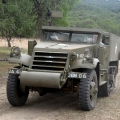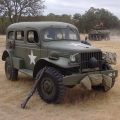 |
 | 1942 Sherman Tank (M4A1) |
The M4 Sherman tank was the mainstay medium tank of the US Armored Forces. It was designed to replace the M3 "Grant" Medium tank based on US armored strategy. The American armored doctrine was that tanks were to be used as infantry support, providing a base of gun fire and opportunity for infantry to move up. It was not designed for tank to tank confrontations. That job, according to doctrine, was for the Tank Destroyer units to do. Unfortunately, this doctrine was proven to be faulty in places like Tunisia and in France where superior German armor had frequent run-ins with Allied tanks.
The M4 Sherman, unlike it's enemy counterparts, were easy to build and easier to maintain. Superior American production allowed these units to be produced en masse. As the US entered the war, weaknesses in the original design became apparent and newer variants were created and produced. Our unit has an M4A1 variant. It packs a 75mm Main Gun and two .30 cal M1919A4 Machine Guns, one coaxial set in the turrent and the other mounted in the bow on a ball turret.
| |
 | 1942 Stuart Tank
(M3A3 & M5A1) |
The M5A1 "Stuart" is the descendent of of the M3 Stuart Light Tank. By 1942, the M5 models were the only light tank being produced. The A1 variant took the modified turret of the M3A3 Stuart, which included a radio bustle section in the rear of it. BY 1943, the primary light tank in the US Armored Forces was the M5A1. This newer variant is the type our unit has.
These upgrades, however, still proved to fall short to the role it was to undertake. Designed as a quick infantry support platform, armed with a 37mm gun and several M1919A4 machine guns, the tanks found itself inadequate on the battle front as early as North Africa, where the British Army had employed their Stuarts against the German Afrika Korps (with the M3 models). The 37mm main gun proved to be too weak and the internal set-up was not condusive to the crew. By 1942, the British removed it from the front and employed their Stuarts in to the roles of reconnaissance. After their experience in the Kasserine Pass, the US Army redeployed their Stuarts, disbanding light tank battalions and attaching only companies to medium tank battalions.
|
 | M3 Halftrack |
The US Army saw a need in being able to keep up infantry with the fast moving armored vehicles. Initially, trucks of varying tonnages were assigned to the tasks. Meanwhile, the Army sought ways to find better protection and the same all-terrain ruggedness for the mounted soldiers who would be following the tanks to, and through, the enemy lines. Prior to the US entrance in to the war, the White Motor Company had come up with a design merging a tractor with half of an M3 Scout Car. The result was the M2 and M3 Halftracks.
The M3 Halftrack was fitted to carry 13 soldiers in to combat, along with all their gear and equipment. The M2 version is shorter by ten inches, has the fuel tanks placed towards the rear, has ammunition storage racks along its sides, and was designed to be an artillery tractor. Quarter-inch steel armor gives the squad some protection from small arms and shrapnel while the catapillar track gives the vehicle and all-terrain function, capable of spanning ditches and trenches. The design was so versatile, the army found other uses for it, and thus a large number of variants appeared. The M3A1 incorporated an armored 'pulpit' ring mount over the passenger side of the cab.
|
 | 1942 Dodge WC-53 Carryall |
During the war, the Army often turned to the civilian commercial sector to find solutions for its needs. To ease production times and costs, it was easier to look to vehicles designs in use by the public, modify them enough to suit the military needs, and slap on a alpha-numeric designation on it. They did this with the Douglas DC-3 passenger plane, military number C-47, and they did it with the Dodge Powerwagon, known to the military as the MC-53 Carryall.
The Carryall was primarily used as a command car. It is unarmored but has plenty of space for seats or radio equipment. Some were even modified and used as ambulances (designated as WC-54). They are versatile and durable trucks and many found lives in rugged civilian careers after the war.
|
 | M-29c/T-24 Weasel |
In the later part of the war, the American government became aware of a Nazi plan to develop atomic weapons. The discovery of a Heavy Water Plant in Norway caused enough concern for the Army to train and plan for an air assault by paratroopers to destroy the site as night bombing was too unreliable at the time. The T-24 Weasel was designed to drop in with them and give them vehicles to traverse the snowy Norwegian terrain. The Weasel has wide tracks to help displace weight on snow and ice, cargo hooks to be loaded under a plane, and is designed with winter in mind. However, the raid was scrubbed after Norwegian commandos set bombs on it and a later American air strike neutralized the plant.
With its original mission no longer applicable, the Weasel found a home with combat engineers and maintenance units. It is believed that during the chaos of D-Day in Normandy, the first vehicle on the beach was a Weasel carrying TNT for the demolition of the obstacles.
|
 | 1/4 Ton Truck - The Jeep |
One of the most popular and common vehicles of the war is the 1/4 ton, 4x4, truck... more fondly referred to as the Jeep. The exact origins of the nickname are highly debated. We'll leave that research and speculation for you to do on your own time. But, whatever the source, the Jeep has become one of the most iconic symbols of American engineering and production ingenuity of WW2.
The original design was made by a small company called Bantam. However, the Army was unsure if Bantam would be able to handle the volume the government needed, so they allowed second design attempts by Willys-Overland and Ford. Willys won the contract, but then licensed the design to Ford in order to facilitate more plants producing the vehicles.
Jeeps can seemingly go anywhere on the battlefield. Simply put. Our jeep owners boast that once you get behind the wheel of one, you'll want one of your own. This is truth. They are reliable, tough as nails, and suitable for any mission. They are also easy to maintain and, essentially, G.I. proof. It is no wonder that war veterans have nothing but fond memories and stories about their experience with them.
|
 | GMC CCKW 353 Truck |
Soldiers can't fight if they can't get there and if they can't be supplied with food, equipment, and ammunition. The largest facilitator of logistics was the 2.5 ton truck. In 1939, the Army Quartermasters requested submissions from various truck manufacturers for a 2.5 ton, 6x6 truck for their logistical purposes. The GMC model was accepted for production and by 1940 roughly 2,500 trucks were made.
The trucks are rugged and suited the Army's Quartermaster needs through and well after the war. They come in a hard cab and soft top, driven by a 6-cylinder engine, and fueled by a 40-gallon tank which can keep it running for nearly 300 miles. The "Duece And A Half" kept running mission after mission with no breaks. The strong workhorse did its job keeping up with the fast moving fronts and supplying troops with the things they needed to win.
|
|
|

